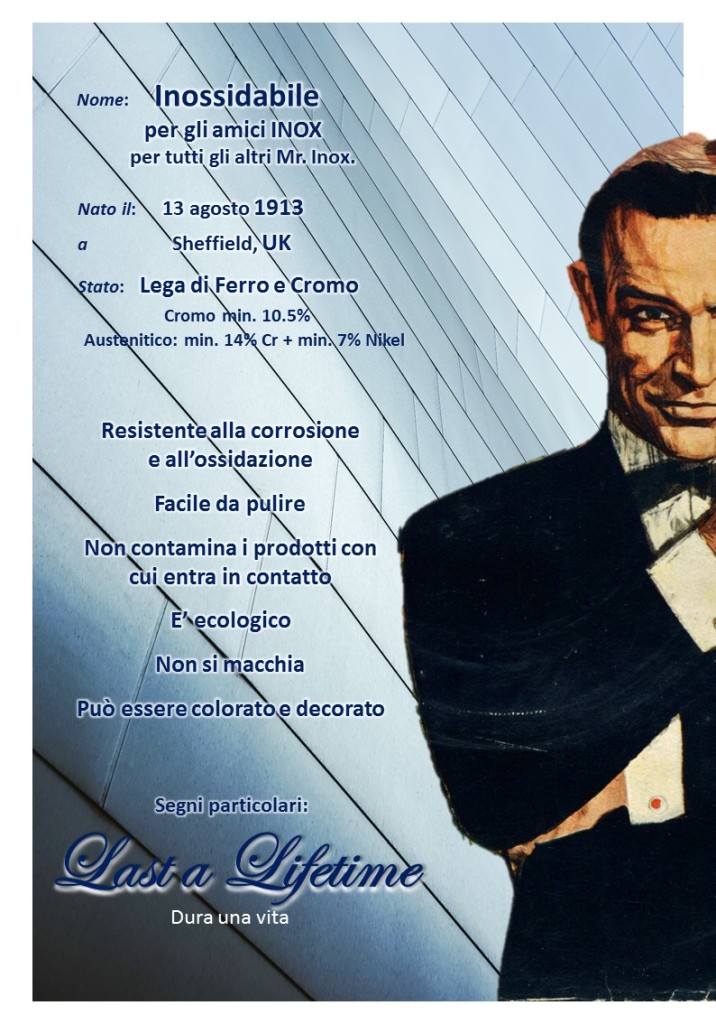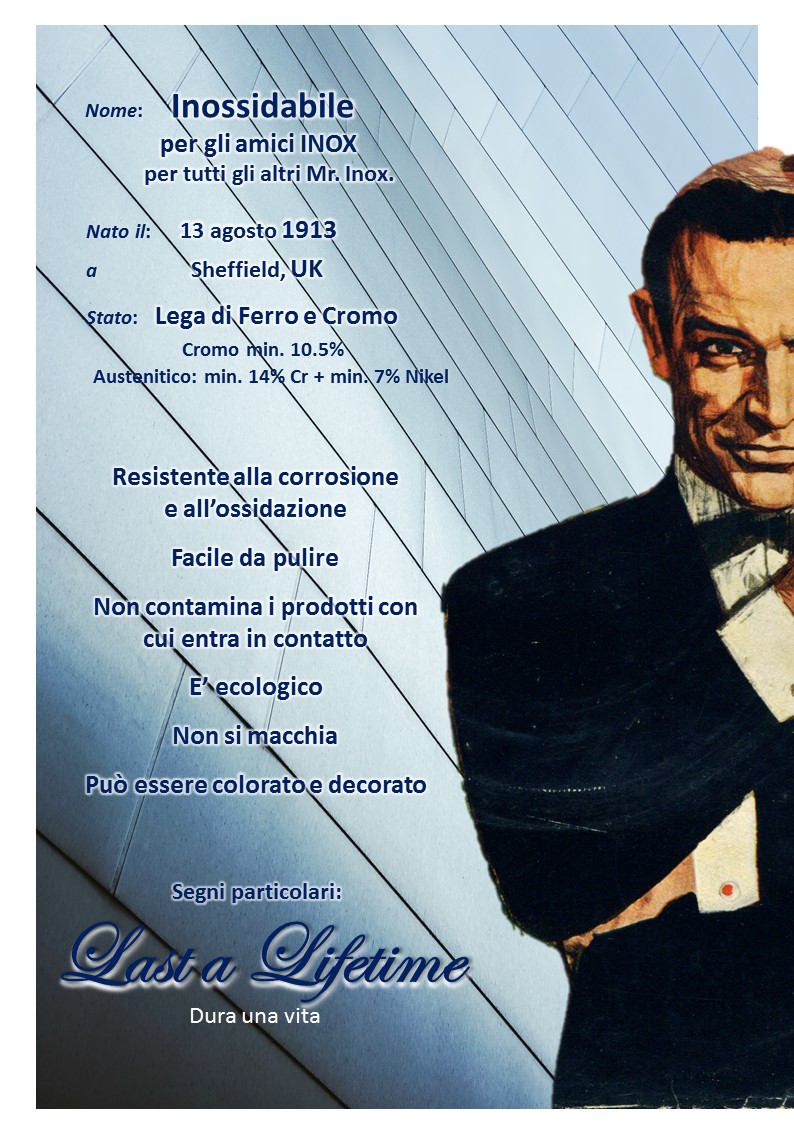Alla scoperta dell’acciaio inossidabile.
Se vi dicessimo che niente può scalfirlo, romperlo o corroderlo. Se vi dicessimo che la sua forza e la sua resistenza non cedono mai e che, come i diamanti, Lui è per sempre. Se vi dicessimo che ha combattuto le due guerre mondiali facendo la differenza, che senza di Lui non saremmo arrivati a vedere la cima dell’Everest, che ha lasciato sue tracce anche sulla Luna e che ha visto la luce in Inghilterra: se vi dicessimo tutto questo, che è solo una parte della sua mirabolante storia, riuscireste a capire perché l’Inox, Mr. Inox, ci ha subito fatto pensare all’agente britannico più famoso del cinema?
Indimenticabile la battuta che pronunciò Sean Connery nel primo film della saga dell’agente segreto 007, altrettanto indimenticabile ci auguriamo possa essere l’incontro ravvicinato con l’acciaio inossidabile.
Con questo articolo inauguriamo una nuova rubrica, dal piglio più informale, per offrire un percorso di introduzione utile ai neofiti dell’inossidabile e un’occasione per gli esperti di scoprire – o rivedere – alcune curiosità sul metallo che ha cambiato il mondo.
 Prima di raccontarvi le “avventure” dell’acciaio inox, a cui abbiamo accennato poco sopra, è indispensabile ripartire dalle basi.
Prima di raccontarvi le “avventure” dell’acciaio inox, a cui abbiamo accennato poco sopra, è indispensabile ripartire dalle basi.
Ecco a voi, quindi, il Signor Inossidabile.
Con la definizione “acciaio inossidabile” si indica una famiglia di leghe di acciaio prodotte dalla fusione di Ferro e Cromo, quest’ultimo in percentuali non inferiori al 10,5% (Rif. Norma EN 10020), a cui è possibile aggiungere altri elementi in quantità minime per ottenere proprietà differenti e specifiche adatte agli usi e alle richieste del cliente finale. In base alla formulazione chimica è possibile identificare tre grossi rami dell’albero genealogico dell’inox: gli acciai inossidabili austenitici, i ferritici e i martensitici, che vedremo più approfonditamente in successive occasioni.
L’acciaio è definito “inossidabile” in quanto non subisce l’azione corrosiva dell’ossigeno, che reagendo col Ferro porterebbe alla formazione della ruggine e all’indebolimento del metallo, esponendolo al rischio di essere danneggiato tanto strutturalmente quanto esteticamente. Questa proprietà è dovuta, però, proprio ad un processo di ossidazione: è il Cromo, infatti, a formare un film di ossido di Cromo che protegge il materiale dalla formazione della ruggine e da altri agenti corrosivi e impurità. Il risultato, gli effetti tangibili, di questa azione preventiva compiuta dal cromo vengono descritti dal nome di battesimo dell’inox: Stainless steel, infatti, letteralmente significa “senza impurità”, immacolato.
Il nome gli venne attribuito non dal suo inventore, bensì dall’uomo che per primo credette nelle potenzialità di questo nuovo prodotto della ricerca metallurgica, sostenendone l’applicazione in campo industriale e fabbricando i primi prodotti in acciaio inox della storia.
Sebbene la comunità scientifica stesse facendo esperimenti nella direzione dell’inossidabile già nel primo ventennio dell’Ottocento, fu solo un secolo dopo, nel 1913, che venne trovato il giusto equilibrio percentuale tra gli elementi e che nacque, quindi, l’inox con tutte le caratteristiche che lo contraddistinguono, prima tra tutte la resistenza alla corrosione.
Non è solo questa qualità che ne motiva il grande successo: significativa per molti settori d’impiego è la facilità di pulizia e l’alto livello di igiene che riesce a garantire; non meno importante è la resistenza al graffio dell’inox rigidizzato; incomparabile la sua inalterabilità nel tempo; di rilievo il fatto che non produca rifiuti pericolosi e non contamini l’acqua e l’ambiente.
Non è possibile concludere questa scheda di presentazione senza accennare al fatto che, in quanto prodotto dal rottame, l’inox è stato precursore e anticipatore dell’attenzione contemporanea alla salute ambientale, e nel tempo ha dimostrato di essere realmente un prodotto eco-friendly: ogni manufatto in acciaio inossidabile, infatti, ha una vita molto lunga, alla fine della quale viene riciclato quasi interamente (90%).
English version
If we should tell you that anything could scratch It, break It or corrode It. If we should tell you that It’s resistance and strength never give up, because It’s like diamonds: It’s forever. If we should tell you It made the difference in both world wars. It was born in UK, humanity wouldn’t see Everest peak without its help and you can find the sign of its passage also on the Moon. If we should tell you that’s just a little part of its incredible story, does the correlation between stainless-steel and the most famous British spy of cinema become clear?
Sean Connery introduction line in the first movie of the 007 saga is unforgettable. We hope the close meeting with Mr. Inox could be as much unforgettable, too.
This post introduces a new informal and enjoyable section of the Inoxblog to help beginners to discover and understand the stainless-steel world. It would be, of course, also an opportunity for specialists to learn something new or review interesting topics about the material that changed the world.
Before telling stainless-steel adventures and deepening the ones we mentioned a little above, an official overview is necessary and unavoidable.
So, here’s to you, Mr. Inox.
The term stainless-steel is used to identify a family of steel alloys made of Iron and Chromium. Regarding European rules (EN 10020) the presence of minimum 10.5% of Chromium it’s required. It’s possible to add small amounts of other elements to the iron-Chromium base to obtain types with different useful properties for a large variety of uses and applications. Three main branches raise on from the stainless-steel family tree: austenitic, ferritic and martensitic. An in-depth analysis will be done forward.
The label “stainless” – lit. without mark – means the oxidation and the rust formation don’t take place, the metal remains clean. However, this feature is due to an oxidation process! Chromium in fact reacts with oxygen creating a protective film of Chromium oxide. The word “inox”, that underlines the paradox, stays for “inoxidizable”, the name by which is known in Italy. Another curiosity about the name is that the adjective “stainless” was not chosen by the scientist who discovered it, but by the first man who believed in the possibility of using this metal in factory production, making the first inox tools of the history. An entire century of scientific researches all over the world passed before the right formula was developed in 1913. From then on the alloy get name and properties those make it appealing, first the corrosion resistance.
Its great success depends on other important qualities: stainless-steel is easy to clean and grants a high hygiene level; the rigidized steel is scrachtproof; this metal has an unequaled high-quality life span and it doesn’t cause water and environment contamination and it doesn’t became dangerous waste.
Since the origins it was produced by recycling scrap, so you can say stainless-steel anticipated the modern environmental sustainability. As time goes by Inox proves its eco-friendly identity: every stainless-steel product has a long lifetime at the end of which is recycled entirely (90%).


Be First to Comment